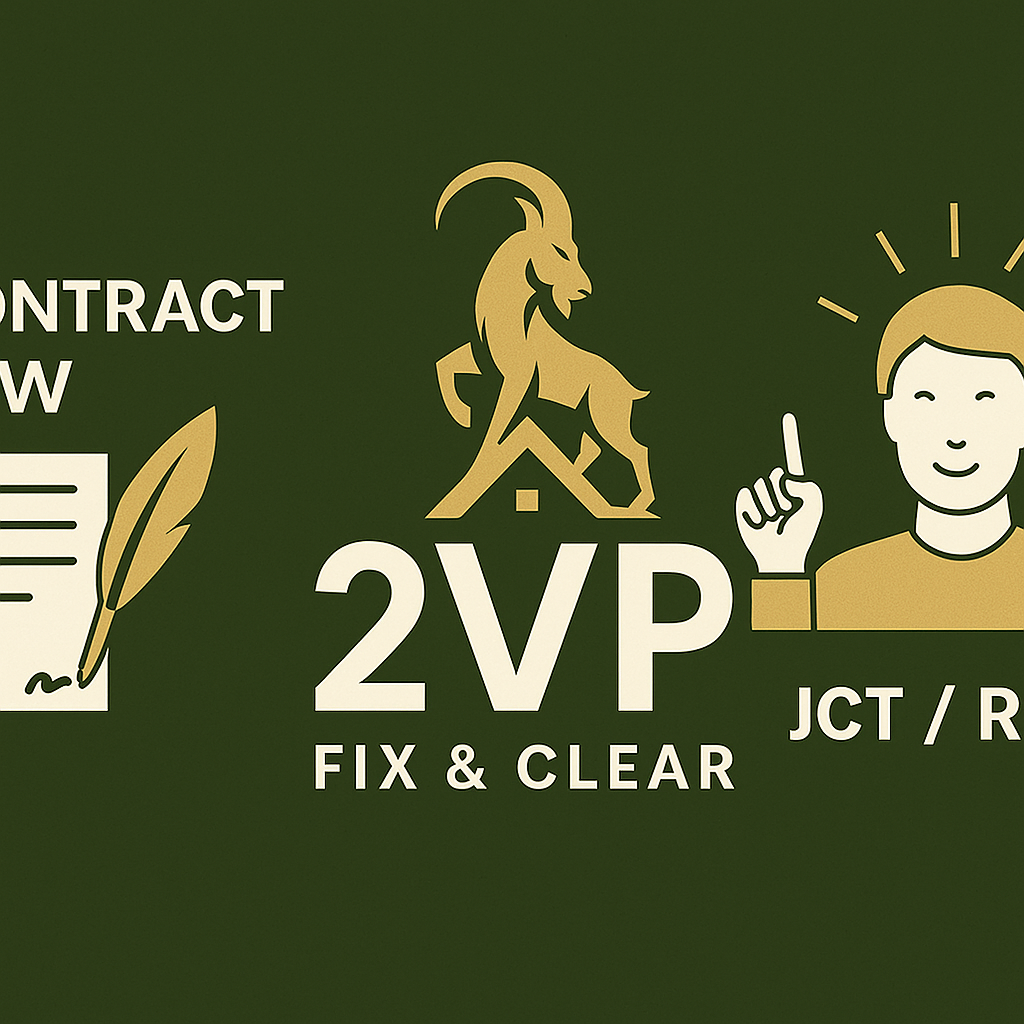Practical Completion vs Building Control: Understanding the Real Difference in Residential Construction Contracts
By 2VP.UK— Experts in RIBA & JCT Contract Delivery for High-End Residential Projects
When building a rear extension, loft conversion, or full house refurbishment, you will often hear two milestones mentioned toward the end of your project:
Practical Completion and Building Control Sign-Off.
They sound similar, but legally and contractually, they mean very different things — and confusing them can delay payments, create unnecessary disputes, or damage the working relationship between client, architect, and contractor.
At 2V Projects Ltd, we’ve helped dozens of architects and homeowners navigate this stage under both RIBA Domestic Contracts and JCT Minor Works forms.
Here’s what every professional and client should know.
🏗️ 1. What Is Practical Completion (PC)?
In both RIBA and JCT contracts, Practical Completion marks the moment when the works are substantially completeand the property is fit for occupation or use.
🔹 Legal Definition:
RIBA Domestic Building Contract 2018 (Clause 9.10.1):
“Practical completion is achieved when the architect or contract administrator considers that the work is completed except for minor defects not materially affecting the use of the property.”JCT Minor Works 2016 (Clause 2.30):
“The Works shall be considered practically complete when they are completed for all practical purposes, notwithstanding minor defects.”
In simple terms:
➡️ The client can safely live or use the space.
➡️ Minor imperfections (e.g. touch-ups, alignment issues, paint marks) do not prevent completion.
🧩 At Practical Completion:
The Contract Administrator (CA) or Architect issues a Practical Completion Certificate.
The Defects Liability Period (Rectification Period) begins (usually 6 months).
Half of the retention (typically 2.5%) is released to the contractor.
The client can move in and start using the property.
Importantly, PC is not linked to administrative tasks like gathering certificates, final invoices, or warranties.
Those can follow shortly afterward.
🏛️ 2. What Is Building Control Sign-Off?
Building Control approval is a statutory process required under the Building Regulations 2010.
It confirms that the works comply with structural, fire, insulation, and safety standards.
It’s managed by either:
The Local Authority Building Control (LABC), or
An Approved Inspector.
🔹 Key Point:
Building Control ensures compliance with national safety regulations,
while Practical Completion concerns the physical and contractual completion of works.
The Building Control Officer may visit before, during, and after construction, issuing:
Interim inspection reports,
And finally a Completion Certificate once all documentation is received (as-built drawings, structural certificates, test reports, etc.).
⚠️ Common Misunderstanding
Many clients assume Building Control Sign-Off = Practical Completion.
That’s incorrect.
Building Control checks legal compliance;
Practical Completion confirms contractual fulfilment.
They can happen weeks or even months apart, especially where paperwork or third-party approvals take longer.
🧱 3. Example: Rear Extension and Loft Conversion
Let’s imagine a typical London residential project:
The contractor finishes all works in December 2024.
The client moves in and starts using the new space.
However, Building Control delays the final certificate until June 2025 due to missing thermal calculations.
In this case, under RIBA 9.10.1 or JCT 2.30,
Practical Completion should be certified in December 2024,
because the building was safe, usable, and substantially complete.
Delaying PC until June 2025 would:
Unfairly extend the contractor’s liability period,
Postpone payment of the retention,
Allow the client to apply unnecessary Liquidated Damages (LDs),
And distort the true completion record.
This situation is common — and a correct understanding of contract law protects both sides.
💡 4. Responsibilities of Each Party
PartyResponsibilityKey Contract ClauseArchitect / Contract AdministratorCertify PC when works are substantially completeRIBA 9.10.1 / JCT 2.30ContractorComplete works to specification, notify readiness for PCJCT 2.27ClientAllow inspection and release payments as per contractRIBA 9.11 / JCT 4.14Building ControlConfirm regulatory compliance independentlyBuilding Regs 2010
🔧 5. After Practical Completion: The Defects Period
Once PC is certified:
The Defects Liability Period (often 6 months) begins.
The contractor must fix any defects attributable to their work at no extra cost.
The client must report issues in writing to the CA.
After this period, the Final Completion Certificate is issued and the remaining retention (2.5%) is released.
This structure ensures fairness and keeps the project professionally managed.
📜 6. What If Building Control Finds Issues After PC?
If Building Control later identifies missing documentation or requires minor corrective works:
These do not invalidate PC.
The contractor or designer can supply documents or make small corrections during the defects period.
Only if major non-compliance or unsafe conditions exist (e.g. missing fire doors, structural instability) can PC be withheld.
🧠 7. Practical Tips for Architects, Designers, and Clients
✅ Issue PC promptly once works are usable — don’t wait for paperwork.
✅ Keep parallel communication between CA and Building Control to avoid confusion.
✅ Document inspections with dated site reports and photos.
✅ Educate the client early — PC is a contractual event, not a regulatory one.
✅ Use clear wording in contracts:
“Administrative delays, including Building Control certification, shall not postpone the date of Practical Completion.”
🤝 8. Why This Matters
Understanding the distinction between Practical Completion and Building Control avoids:
Payment delays,
Unfair retention holdbacks,
Contractual disputes, and
Loss of trust between architect, contractor, and client.
When managed correctly, all parties can close the project confidently — knowing that safety, quality, and contract integrity are all satisfied.
🦌 About 2Vp.uk
At 2V Projects Ltd, we specialise in:
High-quality residential extensions, loft conversions, and full refurbishments.
Working collaboratively with RIBA architects, designers, and homeowners.
Applying both technical expertise and legal precision to every project stage.
We follow JCT and RIBA procedures to protect all parties’ interests, ensuring that completion, payment, and documentation flow smoothly — from first design to final certificate.
📩 Contact us to discuss your next project or request our free guide:
“The Architect’s & Homeowner’s Handbook to Practical Completion.”

